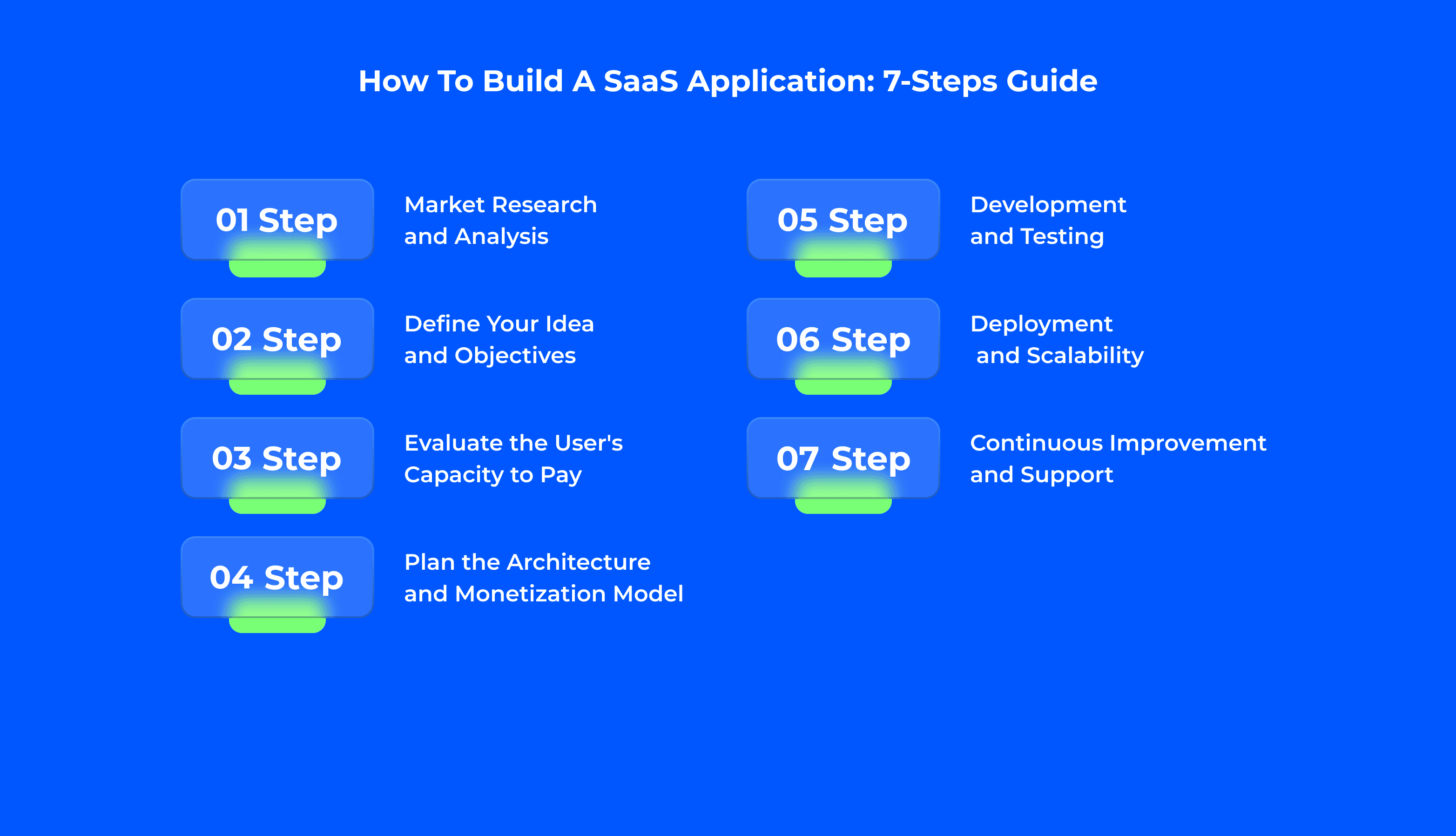SaaS Application Development: All-Purpose Guide

SaaS, or Software as a Service, application development turned things around in how businesses get work done. As more organizations focus their attention on smoothing out processes and adopting cloud technologies, SaaS applications have become their daily bread. Statistics for 2022 confirm that SaaS-based workplaces had 30% higher efficiency than the rest. By 2025, the number of SaaS-powered businesses is expected to reach 85%. So, why is SaaS application utilization so pivotal, and what are the development stages? Find the answers and precise explanations down the line.
SaaS: Meaning and Aim
A business model known as Software as a Service (SaaS) eliminates the need to invest in software, servers, or other applications by offering a subscription-driven service. Through the power of digital clouds, all the necessary processing takes place on remote servers, accessible to users through web browsers, mobile applications, or APIs. In simpler terms, users can seamlessly utilize a comprehensive and ready-to-use online solution.
The bright sample of Saas essence compares with owning transport and buying travel tickets. You feel a clear difference, but at the same time, it is easy to name the positive and negative aspects of both traveling options. You do not care about fuel and spare parts when being passengers; likewise, you do not need to worry about buying and setting up device software delivering technical aspects to the owners. In the case of SaaS, you delegate this task to app providers.
Feel the Advantages of SaaS as a User
Software as a Service has been one of the revolutions in the modern technological world. For the users, it provides many advantages, which is one of the main reasons why businesses and individuals opt for its usage. Here are some advantages that the users may have when using a SaaS application:

- Cost-effectiveness. One of the most prominent advantages of SaaS is the fact that it is cost-effective. Users no longer have to invest in expensive software, hardware, and support services. Instead, they can access the required services through the Internet, paying for only what they use. Such a subscription-based model eliminates high upfront costs, making it a budget-friendly option for all-size businesses.
- Flexibility and scalability. SaaS provides unmatched flexibility to users. As the service provider handles software updates and maintenance, users can quickly scale their usage up or down based on their needs. Whether adding more users, storage capacity, or accessing advanced features, SaaS platforms allow users to adapt to their arising requirements with minimum effort.
- Data Security & reliability. Among the top priorities for SaaS providers have been concerns about data security and reliability. They invest a great deal in strong measures for security, such as the protection of data and its encryption, regular backups, and disaster recovery plans, to ensure that user data is protected, kept private, and safe from intrusion. It can be ensured that users' valuable information is safely stored and protected against any potential threat.
- Accessibility and cross-platform compatibility. The users can access their software solutions anywhere anytime, provided one has access to the internet. This feature is quite important for remote teams or in some instances where an organization has several branches since individuals can be able to communicate and collaborate conveniently.
- Seamless updates & maintenance. It saves the time-consuming activities and technical know-how required, making sure that at any instance the user would enjoy uninterrupted access to the latest version of the software. Thereby, with SaaS, one can utilize the software without spending much time and effort on its maintenance.
- Improved collaboration and integration: The SaaS platform is designed to enforce collaboration and integration between organizations. They facilitate easy sharing of documents, seamless project collaboration, and real-time communication between different departments or teams. It not only improves workflow efficiency but also fosters productivity and teamwork.
Users feel more free and not overloaded with the responsibilities they used to have when owning software. At the same time, they do not lack security measures and accessibility to all the affordable functions.
Samples of SaaS in Practice and Benefits of SaaS Application Building
Today, you may hardly surprise mature users with Google tools like Meet, Keep, Sheets, Docs, etc. Moreover, the work of some users is based on all of these user-friendly products that significantly enhance productivity. However, not all users know that they utilize SaaS applications daily.

A well-known application is Zoom, a widely used video-conferencing application popular during the COVID-19 pandemic. Another popular SaaS application is Dropbox, which simplifies file storage, synchronization, and sharing. We often do not realize that the app we use today is a SaaS-based solution. But what benefits do we receive from crafting SaaS applications?
The advantages of developing SaaS applications are transparent to users, but it may not be immediately apparent how beneficial it can be for startup founders. Let's delve into the benefits of creating a SaaS application business.
- Flexibility in Development. Building a SaaS application is ongoing beyond the initial product launch. Simply having users onboarded does not mean your work is done; it is essential to constantly evaluate app performance and gather user feedback to better cater to their needs. This continuous improvement approach ensures your application stays relevant and user-friendly.
- Regular Revenue. By operating on a subscription-based model, you can enjoy consistent, long-term revenue from loyal customers and new users. This revenue stability allows you to reinvest in your business and continuously refine your product or service offerings.
- Expanding Customer Base. Remember the lower upfront costs mentioned earlier? Well, this advantage works both ways. Since users don't have to incur significant initial expenses, more potential customers can afford to pay for your product. This affordability factor contributes to a more extensive customer base. Additionally, with a SaaS application, you can quickly adapt to new users and integrate enterprise models, widening your market reach.
- Enhanced Customer Value. In the SaaS business model, you can explore your users' needs and customize your application accordingly. It presents a genuine opportunity to create a valuable service that becomes a one-stop solution for your customers. You can retain customer loyalty and provide immense value by consistently iterating and improving your service, even if the initial version received a lukewarm response.
Creating a SaaS application business benefits users and offers numerous advantages to startup founders. The continuous development process, steady revenue stream, broad customer base, and the ability to deliver exceptional value make it an attractive venture.
What Is Essential to Know When Developing a SaaS Application?
Certain factors in developing SaaS applications differentiate it from building traditional apps with a one-time payment structure. Before starting the development process, it is crucial to consider the following aspects:
Selecting the Right Cloud Service Provider
SaaS applications rely on cloud services. Therefore, proper selection of a cloud service provider is so important for the success of your product. Thankfully, choices to select from abound: you can choose between well-known cloud providers, like Microsoft, AWS, or Azure, or opt for local services. Several factors can influence your decision, including:
-
Security. Determine which security services align best with the requirements of your product.
-
Cost allocation. Consider how much you will allocate for a cloud provider.
-
Service. Ensure that the provider offers the necessary services for your business, such as hosting, file storage, databases, and management services.
-
Market Coverage. Evaluate whether the provider operates within your target market.
Upgrading the Security of Your SaaS Application
When running a SaaS business, dealing with databases becomes a regular task. However, the security concerns become even more significant when data is stored in the digital realm, particularly in the cloud. Fortunately, cloud providers like Amazon Web Services (AWS) ensure a rich assortment of security features to address these concerns. AWS provides tools such as firewalls, public access settings, and honeypots, which can eliminate unnecessary traffic, restrict access to specific components, and monitor public repositories.
Seamless Integration with Third-Party Services
Developing a SaaS application normally requires the implementation of different types of functionality to cover the needs of all users. In this respect, everything can hardly be hand-coded since it's cumbersome and requires excessive resources. Well, the good news is that you don't have to reinvent the wheel. You can always integrate any third-party service seamlessly into your app. For example, many applications integrate services like Google Maps, social media platforms, CRM systems, or payment gateways, allowing enhanced functionality without extensive manual coding.

How to Build a SaaS Application: 7-Steps Guide
If you're considering developing a SaaS application, this precise and expert guide will help you navigate the process and ensure the success of your endeavor. So, let's dive in!

Step 1: Market Research and Analysis Thorough market research is the backbone of any successful SaaS application. Analyze your target market, competition, and user needs. Identify trends, pain points, and potential gaps your product can address. This insight will refine your application's core functionality and give you a competitive advantage.
Step 2: Define Your Idea and Objectives The first crucial step is to define your SaaS application idea and set your objectives. Identify the problem your application will solve for its target audience and distinguish your unique selling proposition. This clarity will guide your development process and help you align your efforts toward achieving specific goals.
Step 3: Evaluate the User's Capacity to Pay An essential aspect of creating a SaaS application is ensuring users are willing to pay. Conducting interviews and tests that involve asking relevant and insightful questions is recommended to accomplish this.
Step 4: Plan the Architecture and Monetization Model The architecture and infrastructure of your SaaS application are vital for its stability and scalability. Define a flexible framework that supports high-performance and modular components. Consider cloud-based solutions for cost-effectiveness and scalability. Plan for integrations, data storage, security measures, and a user-friendly interface. Moreover, you must consider the expected revenue and terms for receiving it after your investments. It is essential to ensure the constancy of your service utilization, regularity of income, and all your expenses covered in a predetermined time.
Step 5: Development and Testing Using agile methodologies, break down your SaaS application development into manageable sprints. Develop core features and functionalities iteratively, ensuring each iteration is tested thoroughly. Continuous manual and automated testing helps identify and fix bugs promptly. Regular quality assurance checks will ensure a stable and reliable application.
Step 6: Deployment and Scalability Deploy your SaaS application on reliable and scalable infrastructure. Make use of cloud providers that offer effortless scalability based on user demand. Implement best load balancing, caching, and monitoring practices to ensure optimal performance. Don't forget to establish disaster recovery mechanisms and implement robust security measures.
Step 7: Continuous Improvement and Support The journey doesn't end with deployment. Include regular gathering of user feedback, conduct usability tests, and usage metrics of the application. Iterate, continually improve and add new features to keep the level of competitiveness high for your SaaS application. Provide a responsive support system that quickly solves the user's problems, which helps keep high customer satisfaction.
It needs subsequent planning, research, and enhancement. From the seven basic steps highlighted above, you will be very well-equipped to construct a strong and scalable SaaS application. Move along with each phase, maintaining agility and customer focus, adjusting your fit to change with the needs of your target market.
Price of SaaS Application
The question that may not let you relax is, 'How much should I invest in developing my SaaS application?' Each case is individual and depends on the requirements and complexity of the service. However, there are pivotal factors that play a price-formating role.
- Scope and Complexity. Evaluate the scale and complexity of your application. A more straightforward SaaS may require less investment, while a more complex one might demand additional resources.
- Market Analysis. Conduct a detailed market investigation to identify the demand and competition within your target market. It will help you understand the potential returns on your SaaS investment.
- Development Team. The professionalism and size of your development team can influence costs. Hiring skilled engineers and UI/UX designers will increase expenses but could also enhance the quality of your product.
- Infrastructure and Technology. Determine whether you will build your SaaS application from scratch or leverage existing platforms or frameworks. Investing in robust infrastructure and scalable technologies might be necessary for long-term success.
- Marketing and Customer Acquisition. Allocate a portion of your investment for marketing and customer acquisition strategies. Developing a great product is essential, but reaching and retaining customers is equally crucial for growth.
Remember, the investment required can vary significantly depending on your specific circumstances. Creating a competently compiled business plan and consulting with experts who can provide well-tailored advice based on your unique situation is advisable.
Bottom Line
Development of SaaS apps is not the same as realizing software development ideas since it requires an expert team, constant UI/UX investigations, proactive user support, strategy, and a marketing program. But at the same time, it is worth mentioning that despite the thorny way to SaaS implementation, it is a rewarding and promising business that may ensure stable income when developed smartly. At Yojji, we offer all-purpose expert assistance that will be helpful in the realization of your SaaS ideas at the top-notch level.
Yojji successfully delivered the project within schedule. They demonstrated excellent project management via weekly sprint demos and promptly made adjustments based on the client's feedback. Their responsiveness and collaborative attitude were key elements of their work.

5.0
Yojji was an instrumental part of the client’s team, working closely with them to achieve the product’s success. The team was very collaborative and timely, and their performance was amazing. Additionally, their resources were experienced, professional, and enjoyable to work with.

5.0
Yojii is impressive both in quality of development work as well as their commitment. Strong focus on delivery, highly technical personnel, flexible approach that allows for rapid development. Strong processes that allow for solid controls.

5.0
We’re very happy with the way that Yojji works, which is why we’ve spent so much money and engaged them for such a long time. We treat them as employees in regard to responsibilities and expectations, and they haven’t disappointed us.

5.0
As a company, we find Yojji to be excellent development partners - we cannot recommend them more highly and will be very happy to continue working with them in the future.

5.0
They are really nice people with excellent technical backgrounds.

5.0
We used Agile project management methodology and were in contact with the team and project manager daily.

5.0
They all had a super positive outlook and were dedicated to getting the work completed to a high standard.

5.0
Yojji has delivered an accessible product with thorough consideration for the client's requirements. Users have commented on the platform's user-friendliness and speed. Moreover, the team is easy to communicate with and provides frequent updates. Their development and design skills are impressive.

5.0
